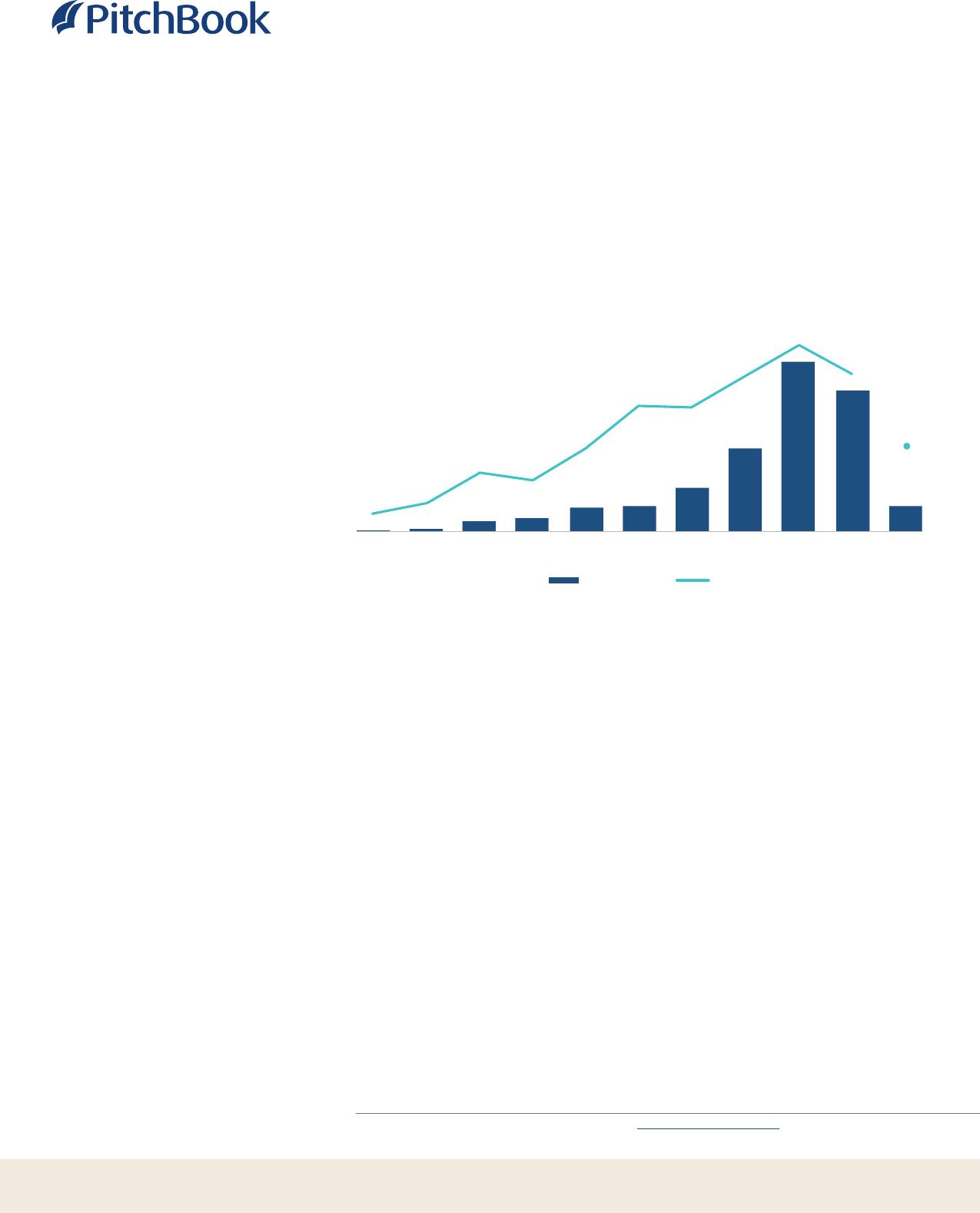PitchBookData,Inc.EmergingSustainableInvestingOpportunities:JohnGabbertFounder,CEOControlled-EnvironmentNizarTarhuniVicePresident,InstitutionalAgricultureResearchandEditorialDanielCook,CFAHeadofQuantitativeResearchHowcontrolled-environmentagriculturecancreateadoublebottomlineoffinancialreturnsandpositiveInstitutionalResearchGroupsocialandenvironmentalImpactAnalysisPitchBookisaMorningstarcompanyprovidingthemostcomprehensive,mostaccurate,andhard-to-finddataforprofessionalsdoingbusinessintheprivatemarkets.AnikkaVillegasAnalyst,FundStrategies&KeytakeawaysSustainableInvestinganikka.villegas@pitchbook.com•Controlled-environmentagricultureisasolutiontotheproblemoffeedingagrowingpopulationwhiledealingwiththechallengesofclimatechange.InsightsdevelopedincollaborationwithAlexFrederick,Sr.Analyst,EmergingTechnology•ThefinancialreturnpotentialofthisopportunityisunderpinnedbyscalingatPitchBookData.demandforsecureandlocalfood,theneedforclimate-resilientagriculture,governmentfundingandregulatorysupport,andtailwindsfromthenaturalandDataorganicfoodsmovements.AlyssaWilliamsSeniorDataAnalyst•Controlled-environmentagriculturehasthepotentialtocreatepositiveenvironmentalImpactsthroughimprovedresourceefficiencyinagriculture,pbinstitutionalresearch@pitchbook.compollutionandcontaminationprevention,anddecreasedtransportationofproduce.Fromasocialperspective,ithasthepotentialtogeneratepositivePublishingImpactsintermsofimprovingfoodsecurity,reducingnegativehumanhealthoutcomes,enablingefficientlandusage,andcreatingqualityemployment.DesignedbyJuliaMidkiffPublishedonDecember20,2023ContentsKeytakeaways1Introduction2Financialreturnpotential4EnvironmentalandsocialImpact8potential1Q42023EmergingSustainableInvestingOpportunities:Controlled-EnvironmentAgricultureIntroductionVenturecapital,oftenservingastheincubatorofemergingtechnologies,iswellpositionedtoinvestwithpositivesocialandenvironmentalImpactgoalsinmind.VenturecapitalistscanutilizetheirexpertiseandresourcestofosterthebusinessesthathavethegreatestpotentialforbothImpactandreturns,especiallywhenkeepinganeyeoncompaniesforwhichsuccessnecessarilymarriesthetwo.Thisfacthasnotgoneunnoticedbyventurecapitalists,whichcomprise39.8%ofthetotalcountofImpactfundsraisedsince2007.1Yetthelandscapeofprospectiveopportunitiesisexpansiveandrapidlyevolving,makingitdifficulttokeeptrackofwhichcompanieshavethegreatestfinancial—andImpact—returnpotential.Emergingopportunitiesoftengobeyondtheinvestmentareastraditionallyassociatedwithsustainability,suchassolarenergyorelectricvehicles,encompassingahostoflesser-knowntechnologies.Evenwithinthefamiliarthemes,nicheinvestmentopportunitiesaredeveloping.Inthisanalystnoteseries,wesurfaceopportunitiesacrossemergingtechnologyverticals—suchasagriculturaltechnology(agtech),mobilitytech,andcarbon&emissionstech—thatwebelievearepoisedtoperformwellwithinthenextdecadefrombothafinancial-returnandanImpact-returnperspective.Indoingso,wehopetohelpguideventurecapitalistspursuingthe“doublebottomline“throughthecomplexlandscapetothemostfruitfulopportunities.Foreachanalystnoteintheseries,insightsaredevelopedincollaborationwithaPitchBookEmergingTechnologyanalystcoveringtherelevantvertical,usingtheirsubjectmatterexpertiseandpreviousresearch,aswellassomeexternalresources,toinformourperspectiveonthespace.Wediscusstheopportunity’smajordriversofreturnpotentialaswellastheinvestmentrisksandobstaclesitfaces.WealsoexploreitssocialandenvironmentalImpactpotential,howtheopportunityfitsintovariousIRIS+Impactthemes,2andpotentialmetricstohelpquantifythoseImpacts.Ultimately,theaimofthisresearchistogiveventurecapitalistsandtheirLPsabetterunderstandingofhowtheopportunitiesalignwiththeirreturnandsustainabilitygoalsandprovidecompaniesoperatinginthesespacesasenseofhowtooptimizeandcommunicatetheirsocialandenvironmentalImpact.1:FormoreImpactfundraisingdata,checkoutour2023ImpactInvestingUpdate.2:TheImpactReportingandInvestingStandards(IRIS+)framework,createdbytheGlobalImpactInvestingNetwork(GIIN),isanindustry-leadingmethodologyaidinginvestorsinsortingImpactinvestmentsbythetypesofImpacttheyaretargeting.LearnmoreabouttheIRIS+categoriesintheGlobalImpactInvestingNetwork’sIRIS+ThematicTaxonomy.2Q42023EmergingSustainableInvestingOpportunities:Controlled-EnvironmentAgricultureThisanalystnotefocusesoncontrolled-environmentagriculture(CEA),whichreferstotechnology-enabledagriculturethatusescontainedandregulatedgrowingconditions,andincludesgreenhousefarming,indoorfarming,andverticalfarming.EmergingCEAcompaniesfrequentlyuseevolvingtechnologiesrelatedtoclimatecontrol,hydroponics,andartificiallighting.3Duetoclimatechangeandtheextremeweathereventsaccompanyingit,CEAislikelytobecomeanecessityinthefutureofglobalfoodproduction—althoughitsproliferationwillnotbewithoutitsdifficulties.Since2013,432VC-backedcompanieshaveenteredtheCEAspace,with$9.4billionininvestment.Controlled-environmentagricultureVCdealactivity166139140112111747552461625$0$0$0.2$0.2$0.4$0.4$0.8$1.4$3.0$2.5$0.520132014201520162017201820192020202120222023Dealvalue($B)DealcountSource:PitchBook•Geography:GlobalAsofDecember5,20233:Foramoredetailedoverviewoftheindoorfarmingspace,downloadourEmergingSpaceBrief:IndoorFarming.3If,andfarmorelikely,whenclimatechangeQ42023EmergingSustainableInvestingOpportunities:Controlled-EnvironmentAgriculturepersistsandintensifies,thedominantCEAplayerswillreaptherewardsofheightenedFinancialreturnpotentialdemandrelativetolimitedsupply,aswillinvestorsinCEAwithpatientcapital.Climatechange’spresentandprojectedimpactsonagriculturalyieldshaveraisedquestionsabouthowtofeedtheworld’sswellingpopulationinthecomingdecades.CEAislikelypartoftheanswerandwillincreasinglybenefitfromconsiderabletailwinds,althoughitalsofacessomemajorobstacles.CEAhashighstartupcostsandcanbecapital-intensiveduetothetypeofinfrastructureandtechnologyitrequires.Itusuallytakesseveralyearsforcompaniestobreakeven,andthetimetoprofitabilityisclosertoeightor10years,makingcompaniesreliantoncontinuedfinancialsupport.Yetif,andfarmorelikely,whenclimatechangepersistsandintensifies,thedominantCEAplayerswillreaptherewardsofheighteneddemandrelativetolimitedsupply,aswillinvestorsinCEAwithpatientcapital.Forthepurposesofthisreport,CEAcompaniesrefertofarmersoroperatorsusingCEAtechnologiesandpracticestogrowandsellproduce,althoughdevelopersofCEAtechnologiesandcomponentswillexperiencesomeofthesametailwindsandrisks.FourkeyfactorssupportCEA’sfinancialreturnpotential:growingdemandforfood,theneedforclimate-resilientagriculture,governmentfundingandregulatorysupport,andthenaturalandorganicfoodmovements.First,globaldemandforfoodisincreasing.TheUNFoodandAgricultureOrganizationpredictsthatapproximately60%morefoodwillbeneededtofeedapopulationof9.3billionpeople,4whichtheworldisprojectedtoexceedwithin30years.5Tofeedthegrowingpopulace,ashifttomoresustainabledietswillbenecessary,requiringlessconsumptionofruminantmeatsuchasbeef,lamb,andgoat,andmoreconsumptionofplant-basedfoods.6Long-termtrendsshowincreasingsharesofconsumerspendinggoingtohigher-valuefooditems,7includingfruitsandvegetables,withdecliningconsumerexpendituresonstaplecropssuchasriceandwheat.8Thesetrendswillintensifyasdevelopingcountriescontinuetourbanize,whichwillalterconsumers’dietsinfavorofhigher-valuefoods.9CEAisideallysuitedtotheproductionofcertainfruitsandvegetables,withsomeofthemostcommonlygrowntypesbeingtomatoes,cucumbers,strawberries,leafygreens,andmicrogreens.10Assuch,CEAcompaniesarewellpositionedtoproducesomeofthetypesoffoodsforwhichdemandwillgrowthemostrapidly.Second,climate-resilientagricultureisbecomingincreasinglynecessary.Thecostsofbillion-dollarextremeweathereventssuchasdroughts,wildfires,floods,severestorms,andcycloneshavebeenscalingsincethe1980s,11withmanyoftheseeventsinvolvingdamagetoagriculturallands,crops,andanimals.12Anthropogenicclimatechangeisgenerallymakingtheseeventsmorelikelyandmoreharmful,13sowithclimatechangeprovingexceedinglydifficulttoreverse,agriculturemustbeableto4:“FeedingtheWorldSustainably,”UnitedNations,UNChronicle,JoséGrazianoDaSilva,June2012.5:“WorldPopulationExpectedtoReach9.8Billionin2050,and11.2Billionin2100,”UnitedNations,DepartmentofEconomicandSocialAffairs,n.d.,accessedDecember5,2023.6:“HowtoSustainablyFeed10BillionPeopleby2050,in21Charts,”WorldResourcesInstitute,JanetRanganathan,etal.,December5,2018.7:PertheUnitedNations,high-valuefoodproductsfitintothreegroups:1)semiprocessedproducts,suchasfreshandfrozenmeats,flour,vegetableoils,roastedcoffee,andrefinedsugar;2)highlyprocessedproductsthatarereadyfortheconsumer,suchasmilk,cheese,wine,andbreakfastcereals;and3)high-valueunprocessedproductsthatarealsooftenconsumer-ready,suchasfreshanddriedfruitsandvegetables,eggs,andnuts.8:“Overview,”USDAEconomicResearchService,September15,2023.9:Ibid.10:“ControlledEnvironmentAgriculture:AFuturisticFixfortheFoodSystem,”L.E.K.,PeterWalter,RobWilson,andShangSaavedra,December1,2020.11:“TimeSeries,”NationalCentersforEnvironmentalInformation,December8,2023.12:“Events,”NationalCentersforEnvironmentalInformation,2023,accessedDecember5,2023.13:“AttributingExtremeWeathertoClimateChange,”CarbonBrief,n.d.,accessedDecember5,2023.4GovernmentfundingandregulatorysupportQ42023EmergingSustainableInvestingOpportunities:Controlled-EnvironmentAgricultureforCEAisontheriseasrecognitionofitseconomic,social,andenvironmentalImpacttoleratemorefrequentandworseextremeweather.Beyondtheseevents,climatepotentialgrows.changealsoresultsinmorepests,weeds,anddiseases;decreasedsoilquality;14andheightenedwaterscarcity—allofwhichfarmerswillneedtomanagemoreeffectivelyinthefuture.15CEAcanhelpaddresstheseissues,withtheprotectivebarrierofagreenhouseoredificereducingtheimpactsofextremeweathereventsaswellasthepresenceofpests,weeds,anddiseases.Further,CEAismorewater-efficient,whichcancreateacostbenefit,andoffersmorecontroloversoilhealth,withtechnologieslikehydroponicsandaeroponicsalsoenablinggrowthwithoutanysoilatall.16Asclimatechange’simpactsmanifestmoredramatically,conventionalgrowerswillstruggletomaintainoutput,andCEAcompanieswillbenefitbyfillinginthegapsinsupply.Third,governmentfundingandregulatorysupportforCEAisontheriseasrecognitionofitseconomic,social,andenvironmentalImpactpotentialgrows.IntheUS,legislationsuchasthe2018AgricultureImprovementAct,alsoknownastheFarmBill,includesprovisionsforgrantspromotingurban,indoor,andemergingfarmingpractices.17AmongthesearemicrograntstosupportlocallygrownfoodusingCEApracticesinfood-insecureareas,demonstratingfederalbuy-intotheideathatCEAcanhelpeliminatefoodswamps.18BeyondCEA-specificfundingopportunities,CEAoperatorscanalsotakeadvantageofmoregeneralistUSDepartmentofAgriculture(USDA)grantsandloans,althoughsometargetingsmallbusinesseswillnotbeapplicableasoperationsscale.19Othercountries,includingSingapore,20theUnitedArabEmirates,21Japan,22andCanada,23alsooffergrants,subsidies,andotherfinancialincentivestoCEAcompanies.Ofnote,pandemic-inducedsupplychaindisruptionsandtheRussia-Ukrainewarhavesparkedanewwaveofconcernsaboutfoodsovereignty,thusincreasinggovernmentinterestinreshoredagriculture,whichmaytranslatetomoresupportforCEAingeographieswhereconventionalagriculturefacesenvironmentalchallenges.Lastly,CEAexperiencestailwindsfromthegrowingnaturalandorganicfoodmovements,24whichwillstrengthenasclimatechangeprogresses.WhilesometypesofCEAsuchasverticalfarmingconjureimagesmorefuturisticthanold-fashioned,CEAproducewilllikelycometobethemorenaturaloption.Duetoclimatechange-inducedsoilerosionandnutrientdepletion,moreaggressiveplantdiseases,andincreasesinthenumberofpests,conventionalfarmerswillneedtoutilizemoresyntheticfertilizers,pesticides,andotherchemicals,aswellasgeneticengineering,intheirproductionprocesses.Withacontrolledenvironment,farmershavelessneedfortheseproductsandtechnologies,whichhaveeachexperienceddegreesofconsumerdistasteinrecentyears.Growersfocusedonparticularly14:“ClimateChangeImpactsonAgricultureandFoodSupply,”USEnvironmentalProtectionAgency,November16,2023.15:“ClimateChangeandAgriculture,”UnionofConcernedScientists,March20,2019.16:“ControlledEnvironmentAgriculture:AFuturisticFixfortheFoodSystem,”L.E.K.,PeterWalter,RobWilson,andShangSaavedra,December1,2020.17:“ControlledEnvironmentAgriculture(CEA)Production,”CongressionalResearchService,August31,2023.18:Foodswampsareareasthathaveaccesstolow-quality,lessnutritious,andmorehighlyprocessedfoods,butlackaccesstoaffordablehigh-quality,nutritious,healthyfoods.19:“ControlledEnvironmentAgriculture(CEA)Production,”CongressionalResearchService,August31,2023.20:“SingaporeLaunches$45MAgritechFundtoBoostUrbanFoodProduction,”AgFundNews,JackEllis,February18,2021.21:“OpportunityAwaitsEarlyInvestorsinRegion’sControlled-EnvironmentAgricultureProjects,”KhaleejTimes,TyronHolgate,September19,2023.22:“Developments,SubsidiesandEntranceofNon-AgroCompanies:HorticultureinJapan,”KingdomoftheNetherlands,2018.23:“What’sDrivingVerticalFarminginCanada?”JDSupra,BennettJonesLLP,MurrayColeman,LorelaiGraham,andJuliaSchatz,May26,2023.24:“NewAcostaGroupStudyHighlightsKeyInfluencesforGrowingBaseofNatural&OrganicShoppers,ReflectingOpportunitiesforBrandsandRetailers,”Acosta,March6,2023.5BetsonCEAdonotnecessarilyassumeQ42023EmergingSustainableInvestingOpportunities:Controlled-EnvironmentAgricultureapricingadvantageunderthepresentconditions,butratherunderfutureonesmadeclimate-vulnerablecropssuchascocoaandcoffee,whichwillrequiremoregeneticlessfavorabletoconventionalagriculturebyorchemicalinterventions,willlikelybenefitthemostfromthisdynamic.climatechange’seffects.IntermsoftherisksandobstaclesfacedbyCEA,therearefourmainconsiderations.FirstandforemostarethehighstartupandoperatingcostsofmanyCEAcompanies,resultinginapathtoprofitabilitythatcantakemorethanadecade.CEAfacilitiesoftennecessitatecomplexandexpensiveinfrastructureandtechnology,andoperatorsmayalsoneedtoinvestinresearch&developmenttoimproveyieldandscalability.Further,expertiseislimited,sohumancapitalcostscanbequitehigh.ForCEAcompaniesutilizingartificiallight,energycostsaresubstantial.And,forurbanCEAgrowers,realestatecanbecostly,atleastcomparedtoruralagriculturalland.ThesechallengeshavebecomeinsurmountableforsomeCEAcompaniesin2023—weknowofatleast15thathaveceasedoperationsorfiledforbankruptcythroughDecember1.Asdiscussedinapreviousagtechreport,withinthenext10years,startupandoperationalcostsareexpectedtoimproveasCEAcomponentenergyefficiencymakesheadwayandasexpertisebecomeslessscarce—moresoifthepricesofCEAtechnologiesfall.Withrespecttoenergy,highcostshavebeenexacerbatedbytheEuropeanenergycrisis,andthereisspeculationthatrenewablespriceswilldecreasemateriallyby2030,butenergycostswilllikelyremainamajordeterminantofreturnonCEAcompaniesintheyearsahead.Thesecondkeyriskiscompetitiveinnature.CEAcompaniesfacecompetitionnotonlyfromotherexistingCEAcompaniesandstartupsthatwillenterthespaceifitprovesmorelucrative,butmoreimportantlyfromincumbentsintheconventionalagriculturespace.Giventhechallengesthatwerejustdiscussed,conventionalagriculturecompanieshaveapricingadvantageoverCEAcompaniesonvariouscroptypes.CEAcompaniesusingindoorandverticalfarmingpracticesarenotwellsuitedtocropswithlonglifecyclesorlowyieldbecauseenergycostsaregreaterrelativetotherevenuefromtheproducegrown.25Manyconventionalfarmsalsobenefitfromgovernmentfunding,whichcontributestotheirpricingadvantage.YetbetsonCEAdonotnecessarilyassumeapricingadvantageunderthepresentconditions,butratherunderfutureonesmadelessfavorabletoconventionalagriculturebyclimatechange’seffects.AndCEAcompanieswithfacilitieslocatedclosertoconsumershaveafreshness—orquality—advantage.Plus,technologicaldevelopmentmaymakeCEAmoresuitabletoabroaderrangeofcroptypesinthecomingyears.Still,conventionalagricultureincumbentsmayalsoadoptCEApracticesastheybecomeenvironmentallynecessary,usingtheirbrandsandexistingrelationshipstogainanedgeoverlesser-knownplayers.Additionally,moremarketentrantswillalsoresultinincreasedcompetitionforgovernmentfunding.Assuch,theseriskswillpersisttoanextent,althoughtheseCEA-adoptingincumbentsmayalsopresentexitopportunitiesforCEAcompanies.ThethirdmajorriskisadoptionriskduetothepriceofproducecreatedusingCEA.RegardlessofwhetheraCEAcompanycanofferbetterpricesorqualitycomparedtotheirCEAandconventionalagriculturepeers,ifthecostofitsproduceistoohighforconsumerstopay,itwillnotbeabletogeneraterobustrevenue.Thiscouldoccurinaneconomicrecession,asconsumerspendingpatternswillshifttowardmoreaffordableproducts,suchasfast-fooditemsratherthanfreshproduce.Ina25:“HowFarCanVerticalFarmingGo?”BBC,WilliamPark,January11,2023.6WhileagriculturehashistoricallybeenaQ42023EmergingSustainableInvestingOpportunities:Controlled-EnvironmentAgriculturelesspartisanissue,withtheconventionalagriculturelobbyintheUSpossessingrecessionaryscenario,growersproducingfoodsthatareconsiderednecessitiesorsignificantinfluenceoverbothpoliticalparties,inferiorgoodssuchaspotatoes,greenbeans,oronionsarelessvulnerabletothissustainability-andclimate-relatedtopicssuchrisk,whilethoseproducingitemsthatcouldbecomeluxuryfoodsornonessentialsasresilientagriculturearemorecontroversial.suchaschocolateorcoffeearemorevulnerable.Slightlyreducingthelikelihoodofthisriskisthefactthatgovernmentstypicallyusesubsidiestohelpkeepcommoditypriceslow,sointhecaseofindustry-wideeventsimpactingtheabilityofconsumerstopurchaseproduce,governmentinterventionmayprovidesomeresolution.Onanothernote,evenifaCEAcompanycanofferbetterqualitycomparedtotheirconventionalagriculturepeers,ifthepricedifferentialbetweentheproduceofthetwoissubstantial,manyconsumerswilloptforthelessexpensive.Wehaveseenthismanifestinrecentyears,withpremiumpricinglikelycontributingtothedifficultiescausingsomeCEAcompaniestoclosetheirdoors.26Thefinalriskispolitical,relatedtothepotentiallossofgovernmentfunding.TotheextentthatCEAcompaniesrelyongovernmentsubsidiesortaxbenefitsasaconsistentcomponentoftheirbusinessmodel,shiftsinpolicyresultingintheeliminationofthoseprogramscouldsubstantiallyimpactthebottomline.ThisismorelikelytooccurinnationswherethereareeconomicconditionsconstrainingtheabilityofthegovernmenttofundvariousprogramsorincountriessuchastheUSwherelargeswingsfromoneendofthepoliticalspectrumtotheotheraremorecommon.Whileagriculturehashistoricallybeenalesspartisanissue,withtheconventionalagriculturelobbyintheUSpossessingsignificantinfluenceoverbothpoliticalparties,sustainability-andclimate-relatedtopicssuchasresilientagriculturearemorecontroversial.Assuch,programsfocusedexclusivelyonCEAratherthanagriculturemoregenerallyarelikelyatgreaterrisk.Nonetheless,asCEAprovesnecessarytoproduceenoughfoodforacountry’sinhabitants,contentionarounditwillwane.26:“InfarmAbandonsEuropefor‘RegionsBetterSuitedtoIndoorFarming,’”JustFood,SimonHarvey,May17,2023.7Q42023EmergingSustainableInvestingOpportunities:Controlled-EnvironmentAgricultureEnvironmentalandsocialImpactpotentialRelevantIRIS+categories:27AgricultureBiodiversity&ClimateEcosystemsHealthDiversity&InclusionEmploymentLandPollutionWaterCEAhasamoderate-to-highenvironmentalImpactpotentialatpresent,whichwilllikelyexpandinthenext10yearsastechnologiesimprove,adoptionscales,andmorerenewableenergybecomesavailable.TheseenvironmentalImpactsaremanifold.OnemajordimensionoftheImpactpertainstoresourceefficiency.ManyCEAfarmsareclosedsystems,whichallowforcontroloverlight,water,temperature,humidity,nutrients,anddetrimentalvariablessuchaspests,weeds,anddisease.Assuch,theycanbemoreresource-efficient,28particularlyintermsofwaterusageandespeciallyinthecaseofhydroponicsandaeroponics.Themostwater-efficientgrowingmethodspotentiallyrequire98%lesswaterthanconventionalfarming.29SomeoftheseefficienciesareinherenttoCEA,butothersrequireadditionalinvestmentintechnologyorotherinputs,soachievingmaximalresourceefficiencymaynotbeeconomicallyrationalabsentadditionalgovernmentincentives.Still,theeconomicallyviableresource-efficiencyimprovementsalonecanhaveasizableenvironmentalImpact.TheexceptiontoCEA’spotentialresourceefficiencyisenergy,asCEAgrowerscanusemorethan15xtheamountofenergythatconventionalgrowersdo.30Asidefromtheoperational,adoption,andcompetitiveobstacles,thisisthegreatestrisktoachievingnet-positiveenvironmentalImpactsthroughCEA.Totheextentthatthe27:“IRIS+ThematicTaxonomy,”GlobalImpactInvestingNetwork,April2023.28:“NE1835:ResourceOptimizationinControlledEnvironmentAgriculture,”NIMSS,September30,2023.29:Foranin-depthbreakdownofhowtheseefficienciesarepossible,downloadouranalystnoteCultivatingOpportunitiesinIndoorFarming.30:“2021GlobalCEACensusReport,”AgritectureandWayBeyond,n.d.,accessedDecember5,2023.8CEAhasthepotentialtoimprovebiodiversity,Q42023EmergingSustainableInvestingOpportunities:Controlled-EnvironmentAgriculturereduceagriculture’scontributiontoclimatechange,andpreventthecontaminationofenergyconsumedbyCEAfacilitiesisnotderivedfromrenewablesorothercleandrinkingwater,whichisgrowingmorescarce.sources,CEAwillcontributenegativelytoclimateissues.However,morerenewableenergyisbecomingavailableeveryyear,andenergyconsumptionisexpectedtoimproveasprecisionagriculture,smartgrids,andotherenergy-efficiencytechnologiesmakestrides,aswediscussinourCultivatingOpportunitiesinIndoorFarminganalystnote.AnotherdimensionofCEA’spositiveenvironmentalImpactpotentialrelatestothepreventionofpollutionandcontaminationevents.Inconventionalagriculture,approximately80%ofnitrogenandfrom25%to75%ofphosphorousappliedtofieldsislosttotheenvironment.31Theselosseslargelyendupinbodiesofwaterthroughleachingandrunoff,whichharmsaquaticbiodiversityandwaterqualityandcreatesmoregreenhousegasemissionsfromthebodiesofwater.32CEA’sabilitytocreateclosedsystemsalsomeanstheabilitytocontrolrunoff,whichcanresultinlesspollutionfromchemicalsandsyntheticfertilizers,evenifapproachesarenotfullycircular,meaningtheydonotreuseallwastefromthegrowingprocess.CEAalsofacilitatesmoreaccurateandfrequentmonitoringofnutrientsavailabletocrops,thusallowingformoreprecisenutrientmanagementandreducingtheamountofchemicalinputsneededandeventuallydiscarded.33Assuch,CEAhasthepotentialtoimprovebiodiversity,reduceagriculture’scontributiontoclimatechange,andpreventthecontaminationofdrinkingwater,whichisgrowingmorescarce.ThefinalmajordimensionofenvironmentalImpactisthatCEAcanreducetheamountoftransportationneededtobringproducetoconsumers.CEAfacilitiescanbelocalizedtocommunitiesinanyenvironmentinsteadofjusttheruralcommunitiesthatnaturallyexperienceadvantageousgrowingconditions,sothedistancetoconsumers—especiallyonesinurbanareas—canbecutsignificantly.Asaresult,transportation-relatedairpollutionandcarbonemissionsandtheirassociatedenvironmentalandclimateImpactscanbecurtailed.Furthermore,foodwasteduetospoilageinthetransportationprocesscanbereduced,therebydecreasinggreenhousegasemissionsfromfoodwaste.ThisImpactisespeciallyrelevanttocountriesthatimportthemajorityoftheirfoodduetoinhospitablegrowingconditions,soImpactcanbeoptimizedbyestablishingCEAfacilitiesinthoseareas,aswellasurbanonesorthosefarfromconventionalfarms.IntermsofsocialImpact,CEA’spotentialismoderateandexpectedtoincreasewithinthenextdecadewithimprovedadoptionandtechnology.ThefirsttypeofsocialImpactgeneratedthroughCEAistiedtoaccesstofresh,safe-to-eatproduce,whichisvitaltohumanhealthanddevelopment.Insufficientquantitiesoffreshfruitsandvegetablesinthehumandietareassociatedwithcardiovasculardisease,obesity,Type2diabetes,andsometypesofcancers,makingaccesstothemapublichealthissue.34Further,thisissuedisproportionatelyaffectscommunitieswithhighpovertyandhighminoritycomposition,soimprovingaccesshelpstomitigatesystemicinequalities.3531:“OurNutrientWorld:TheChallengetoProduceMoreFoodandEnergywithLessPollution,”UNEnvironmentProgramme,2013.32:“TheGlobalizationofCulturalEutrophicationintheCoastalOcean:CausesandConsequences,”USEnvironmentalProtectionAgency,HeroandEnvironmentalHealthResearchOnline(HERO),TCMaloneandA.Newton,2020.33:“CEASystems:TheMeanstoAchieveFutureFoodSecurityandEnvironmentalSustainability?”Frontiers,NicholasCowan,etal.,June15,2022.34:“Only1in10AdultsGetEnoughFruitsorVegetables,”CDC,February16,2021.35:“IncreasingAccesstoFruitsandVegetables:PerspectivesFromtheNewYorkCityExperience,”NationalLibraryofMedicine,NationalCenterforBiotechnologyInformation,RachelSacks,MPH,StellaS.Yi,Ph.D.,andCathyNonas,MS,RD,May2015.9AgriculturalrunoffdoesnotonlyaffecttheQ42023EmergingSustainableInvestingOpportunities:Controlled-EnvironmentAgricultureenvironment;itcanalsohaveserioushumanhealthimplications.Already,somecompaniesoperatingnetworksofsmallfacilitieshaveworkedtoprovidefreshproducetocommunitiesdealingwithfoodswamps.Additionally,fruitsandvegetablesproducedbyCEAgrowersmaybelowerriskforfoodborneillnessduetoshorter,morecontrolledproducesupplychains.36WhilethesepotentialImpactsarepresentlymoreminor,theywillballoonasclimatechangereducesagriculture’sabilitytoproducethenecessarycropyieldstofeedtheglobalpopulation.Affordabilityfactorsintothisequation,sopotentialImpactwillincreaseifaffordabilitydoes,duetoeithergovernmentsubsidiesortechnologicaladvancements.ThesecondtypeofsocialImpactisrelatedtoCEA’sabilitytopreventpollutionandcontaminationassociatedwithleachingandrunoff.Agriculturalrunoffdoesnotonlyaffecttheenvironment;itcanalsohaveserioushumanhealthimplications.Runoffcarryingnitrogenfromagriculturalfertilizersoftenmakesitswayintodrinkingwater,andthentothehumanbody.Studieshaveshownthatexcessnitrogenislinkedtooutcomessuchascancer,reproductiveimpacts,hypothyroidism,andmethemoglobinemia,alsoknownasbluebabysyndrome,inwhichthereisinsufficientoxygenpresentinbodytissues.37Whilemanydevelopednationshavebannedtheuseofbroad-spectrumandpersistentpesticidessuchasDDTandsomeorganophosphatesduetotheircreationofacuteandpotentiallychronicnegativehealthimpacts,theyarestillinuseinsomelessdevelopednations.38Thesepesticidesarealsocarriedintodrinkingwaterthroughrunoff.PreventionofcontaminationandpollutionusingCEAstillrequiressomeintentionality,butCEAnonethelessfacilitatesthepreventionofsucheventsanddecreasestheirlikelihoodofoccurring.ThethirdtypeofsocialImpactthatCEAhasthepotentialtogenerateisrelatedtoreducedlandrequirements,whichcouldcontributetolandrehabilitationforformerconventionalagriculturallandandleavemorespaceforurbanandruralgreenspaceslikeforestsandparks.39NotalltypesofCEAinvolvelesslandusage,butverticalfarming,rooftopfarming,andhydroponicgreenhousescanuseanywherefrom10xto300xlesslandincomparisontotraditionalequivalentoutdoorgrowthscenarios.40Arableland,orlandthatcanbeploughedandusedtogrowcrops,isbecomingincreasinglyscarce.Asof2015,33%oftheworld’sarablelandhadbeenlosttoerosionorpollutionintheprevious40years.41Rehabilitationofagriculturallandwillbenecessaryifwearetofeedtheglobalpopulation,andCEAcreatestheabilitytomaintainthefoodsupplywhileallowingthetimeandspaceforthistooccur.Furthermore,withlessagriculturallandusage,morelandcanbeusedforgreenspaces,whichpromotehumanhealthbycreatingspaceforphysicalandsocioculturalactivities.42Plus,urbanverticalfarmingcanallowoperatorstoconvertvacantwarehousesintofarms,whichisamoreefficientuseofrealestatecomparedtobuildingnet-newCEAfacilities.36:“ClimateChangeandFoodSafetyRisk,”TuftsUniversity,ElenaN.Naumova,June29,2022.37:“ReducingtheHealthImpactsoftheNitrogenProblem,”NationalLibraryofMedicine,NationalCenterforBiotechnologyInformation,September2021.38:“WaterPollutionFromAgriculture:AGlobalReview,”FoodandAgricultureOrganizationoftheUnitedNations,JavierMateo-Sagasta,etal.,2017.39:“WhatIsLandRehabilitation?”Investopedia,AdamHayes,May25,2022.40:“IndoororIn-Field:ClimateImpactsofControlledEnvironmentGrowth,”WelshGovernmentFarmingConnect,Dr.DavidCutress,February9,2022.41:“SoilLoss:ASustainableModelforIntensiveAgricultureBriefingNote,”GranthamCentreforSustainableFutures,December2,2015.42:“ValueofUrbanGreenSpacesinPromotingHealthyLivingandWellbeing:ProspectsforPlanning,”NationalLibraryofMedicine,NationalCenterforBiotechnologyInformation,AndrewCheeKengLee,HannahC.Jordan,andJasonHorsley,August27,2015.10CEAcanbringhigh-paying,high-quality,high-Q42023EmergingSustainableInvestingOpportunities:Controlled-EnvironmentAgricultureeducationjobstoregionscharacterizedbyunemploymentandlow-paying,lowquality,ThefinalsocialImpactopportunityisrelatedtothequalityofemploymentprovidedandlow-educationjobs,therebycreatingabyCEAcompaniescomparedtoconventionalagriculturefarms.Accordingtothesocioeconomicbenefit.CentersforDiseaseControlandPrevention(CDC),agriculturecurrentlyranksamongthemosthazardousindustries,withfarmersathighriskforbothfatalandnonfatalinjuries.43Transportationincidentsaretheleadingcauseofdeathforfarmersandfarmworkers,andCEAreducestheamountoftransportationnecessaryforagriculture,thusmitigatingthisrisk.Farmworkersarealsoatincreasedriskforlacerations,fractures,amputations,hearingloss,respiratorydisorders,arthritis,andcancer,amongothernegativeoutcomes.44WhileCEAdoesnotminimizethelikelihoodofalltheseimpacts,itdoesinvolvelessuseofheavymachinerysuchastractorsorcombines,andaspreviouslymentioned,canreducethequantityofpesticidesandamountoffertilizernecessaryforgrowth,thusreducingrespiratoryrisks.Ofcourse,CEAisnotfreeofemployeehealthandsafetyrisks,socomprehensiveprogramsusedtoassessandaddressthemastheyarisearenecessarytoensurethispositiveImpactiscreated.Additionally,CEAcanbringhigh-paying,high-quality,high-educationjobstoregionscharacterizedbyunemploymentandlow-paying,low-quality,andlow-educationjobs,therebycreatingasocioeconomicbenefitaswell.43:“AgriculturalSafety,”CDC,March3,2023.44:“OccupationalandEnvironmentalHealthRisksinFarmLabor,”NationalLibraryofMedicine,NationalCenterforBiotechnologyInformation,ThomasA.ArcuryandSaraA.Quandt,October2,2019.11Q42023EmergingSustainableInvestingOpportunities:Controlled-EnvironmentAgricultureOthernotesintheEmergingSustainablePotentialImpactmetricsInvestingOpportunitiesseriesAsdiscussedinourESG,Impact,andGreenwashinginPEandVCanalystnote,manyCultivatedProteinGPsandLPsconsidermeasurementanecessarycomponentofanImpactinvestmentDownloadthereporthereprogram.ThefollowingmetricscanbeusedtoquantifythepositivesocialandenvironmentalImpactsdiscussedinthereport,includingbycompaniespitchingtheirTransitTechpositiveImpactstosustainability-orientedGPsandGPscollectingImpactmetricsonDownloadthereportheretheirportfoliosforinternaltrackingandmonitoring,amongothers:45Waste-to-Fuel•PoundsofproducegrownusingCEA.Downloadthereporthere•Poundsofproducedistributedtolocalcommunities.•Poundsofproducedistributedtolow-incomecommunities.•Averagetransportationdistancefromfacilitytovendororconsumer.•Waterconsumptionperunitofproducedistributedcomparedtostandardagriculturalpractices.•Percentageofenergyusedforproductionthatisderivedfromrenewablesourcessuchassolarandwind.•Numberofrecallsorotherfoodsafetyincidentsassociatedwithcompanyproduce.•Numberofjobscreatedbythecompany.CarbonUtilizationDownloadthereporthere45:Ofnote,thesemetricsaretailoredtothespecificopportunitydiscussed,andassuch,someofthemwillnotaggregatemeaningfullyattheLPportfoliolevel.Readmoreabouttheuseofcustomizedversusstandardizedmetricsin“AssessingComparability:TheIndicatorsDilemma,”EVPA,GianlucaGaggiotti,etal.,September12,2023.COPYRIGHT©2023byPitchBookData,Inc.Allrightsreserved.Nopartofthispublicationmaybereproducedinanyformorbyanymeans—graphic,electronic,ormechanical,includingphotocopying,recording,taping,andinformationstorageandretrievalsystems—withouttheexpresswrittenpermissionofPitchBookData,Inc.Contentsarebasedoninformationfromsourcesbelievedtobereliable,butaccuracyandcompletenesscannotbeguaranteed.Nothinghereinshouldbeconstruedasinvestmentadvice,apast,currentorfuturerecommendationtobuyorsellanysecurityoranoffertosell,orasolicitationofanoffertobuyanysecurity.Thismaterialdoesnotpurporttocontainalloftheinformationthataprospectiveinvestormaywishtoconsiderandisnottoberelieduponassuchorusedinsubstitutionfortheexerciseofindependentjudgment.12



 VIP
VIP VIP
VIP VIP
VIP VIP
VIP VIP
VIP VIP
VIP VIP
VIP VIP
VIP VIP
VIP VIP
VIP